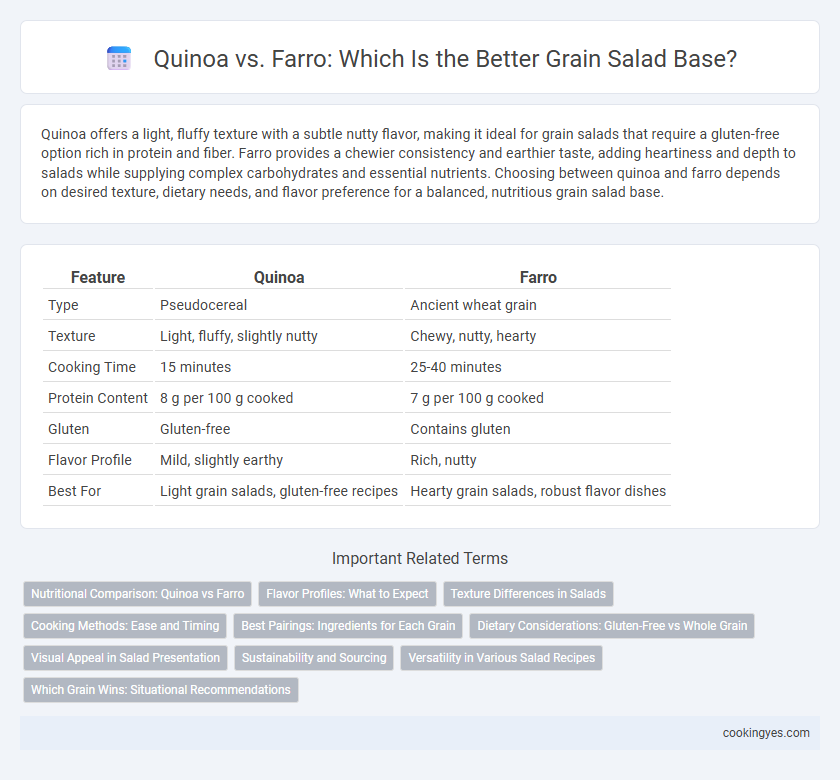Quinoa offers a light, fluffy texture with a subtle nutty flavor, making it ideal for grain salads that require a gluten-free option rich in protein and fiber. Farro provides a chewier consistency and earthier taste, adding heartiness and depth to salads while supplying complex carbohydrates and essential nutrients. Choosing between quinoa and farro depends on desired texture, dietary needs, and flavor preference for a balanced, nutritious grain salad base.
Table of Comparison
| Feature | Quinoa | Farro |
|---|---|---|
| Type | Pseudocereal | Ancient wheat grain |
| Texture | Light, fluffy, slightly nutty | Chewy, nutty, hearty |
| Cooking Time | 15 minutes | 25-40 minutes |
| Protein Content | 8 g per 100 g cooked | 7 g per 100 g cooked |
| Gluten | Gluten-free | Contains gluten |
| Flavor Profile | Mild, slightly earthy | Rich, nutty |
| Best For | Light grain salads, gluten-free recipes | Hearty grain salads, robust flavor dishes |
Nutritional Comparison: Quinoa vs Farro
Quinoa offers a complete protein profile with all nine essential amino acids, containing approximately 8 grams of protein and 5 grams of fiber per cup cooked, making it ideal for a nutrient-dense grain salad base. Farro provides more carbohydrates and fiber, around 6 grams of protein and 7 grams of fiber per cup cooked, along with higher amounts of magnesium and iron, supporting digestive health and energy metabolism. Both grains are rich in antioxidants, but quinoa is naturally gluten-free, appealing to dietary restrictions, while farro provides a chewy texture and nutty flavor that enhances salad complexity.
Flavor Profiles: What to Expect
Quinoa offers a mild, slightly nutty flavor with a fluffy texture ideal for light, refreshing grain salads. Farro provides a chewier bite and a rich, nutty taste that adds depth and heartiness to robust salad recipes. Choosing between quinoa and farro depends on whether you prefer a delicate or more substantial flavor and texture profile in your grain salad base.
Texture Differences in Salads
Quinoa offers a light, fluffy texture with a slight crunch, making it ideal for salads that benefit from a delicate bite and quick digestion. Farro provides a chewier, heartier texture, adding substantial body and a nutty flavor that holds up well in robust salad blends. Choosing between quinoa and farro as a grain salad base depends on the desired mouthfeel and the accompanying ingredients' textures.
Cooking Methods: Ease and Timing
Quinoa cooks faster than farro, typically requiring 15 minutes of simmering compared to farro's 25 to 40 minutes, making it ideal for quick meal prep. Farro often benefits from soaking and slower simmering to achieve a chewy texture, which adds depth to grain salads but demands extra planning. Both grains can be cooked by boiling or steaming, but quinoa's quicker absorbency and fluffier outcome simplify the assembly of fresh and vibrant grain salads.
Best Pairings: Ingredients for Each Grain
Quinoa pairs exceptionally well with ingredients like chickpeas, cherry tomatoes, cucumbers, fresh herbs such as parsley and mint, and tangy lemon vinaigrette, enhancing its light, nutty flavor and fluffy texture. Farro complements robust ingredients such as roasted vegetables, kale, parmesan cheese, toasted nuts like pine nuts or walnuts, and balsamic glaze, providing a chewy texture with a slightly sweet, earthy taste. Both grains serve as versatile bases but choosing quinoa suits fresh, Mediterranean-inspired salads while farro excels in hearty, rustic grain bowls.
Dietary Considerations: Gluten-Free vs Whole Grain
Quinoa serves as an excellent gluten-free option for grain salad bases, making it ideal for those with gluten sensitivities or celiac disease. Farro, a whole grain wheat, offers a rich, nutty flavor and provides higher fiber and protein content but contains gluten, limiting its suitability for gluten-free diets. Choosing between quinoa and farro depends on dietary restrictions, with quinoa supporting gluten-free needs and farro delivering whole grain nutritional benefits.
Visual Appeal in Salad Presentation
Quinoa offers a light, fluffy texture with tiny, pearl-like grains that create a visually appealing, speckled pattern in salad presentations. Farro provides a heartier, chewier bite with a rich, nutty color and larger, elongated grains, adding an earthy, rustic look to the base of grain salads. The contrasting shapes and hues of quinoa and farro significantly influence the overall visual appeal, allowing chefs to tailor salad aesthetics according to their desired presentation style.
Sustainability and Sourcing
Quinoa, primarily sourced from the Andean regions of South America, is favored for its drought-resistant properties and relatively low water usage compared to farro, which is a wheat grain cultivated mainly in Italy and the Mediterranean. Farro relies on more intensive farming practices and higher water consumption, making quinoa a more sustainable choice for grain salad bases. Choosing quinoa supports biodiversity and benefits indigenous farmers, while farro's sourcing aligns with traditional European agriculture but has a larger environmental footprint.
Versatility in Various Salad Recipes
Quinoa offers exceptional versatility as a salad base due to its light texture and ability to absorb diverse flavors, making it ideal for both Mediterranean and tropical-inspired grain salads. Farro provides a chewy, nutty flavor that complements robust, hearty ingredients often found in autumnal or rustic salads. Both grains adapt well to various dressings and mix-ins, allowing customization across a wide range of salad recipes.
Which Grain Wins: Situational Recommendations
Quinoa offers a high-protein, gluten-free option with a fluffy texture that absorbs dressings well, making it ideal for light, fresh salads and those with dietary restrictions. Farro provides a chewy, nutty bite packed with fiber and iron, perfect for hearty, warm salads or recipes requiring robust textures and flavors. Choosing between quinoa and farro depends on the desired salad style, nutritional needs, and textural preferences, with quinoa favored for versatility and health-conscious dishes, while farro excels in rustic, filling salads.
Quinoa vs Farro for grain salad base Infographic

 cookingyes.com
cookingyes.com